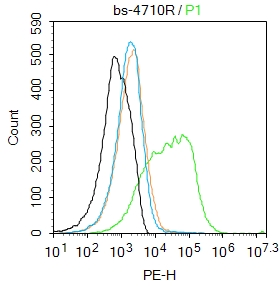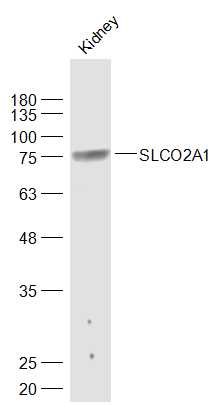SLCO2A1 Rabbit pAb
SLCO2A1 Rabbit pAb
- 产品详情
- 实验流程
- 背景知识
Application
| WB |
|---|---|
| Primary Accession | Q92959 |
| Reactivity | Human |
| Host | Rabbit |
| Clonality | Polyclonal |
| Calculated MW | 70044 Da |
| Physical State | Liquid |
| Immunogen | KLH conjugated synthetic peptide derived from human PGT/Slco2a1 |
| Epitope Specificity | 611-643/643 |
| Isotype | IgG |
| Purity | affinity purified by Protein A |
| Buffer | 0.01M TBS (pH7.4) with 1% BSA, 0.02% Proclin300 and 50% Glycerol. |
| SUBCELLULAR LOCATION | Cell membrane; Multi-pass membrane protein. |
| SIMILARITY | Belongs to the organo anion transporter (TC 2.A.60) family. Contains 1 Kazal-like domain. |
| Important Note | This product as supplied is intended for research use only, not for use in human, therapeutic or diagnostic applications. |
| Background Descriptions | The organic anion transporting polypeptide (OATP) family of proteins play a role in drug absorption, distribution and excretion. OATP proteins mediate the uptake of a broad range of substrates, including bile salts, hormones, drugs and antibiotics, and they are expressed in various tissues, such as gut, brain, kidney and liver. PGT, also known as SLCO2A1 (solute carrier organic anion transporter family, member 2A1), SLC21A2 or OATP2A1, is a 643 amino acid multi-pass membrane protein that belongs to the organic anion transporter family. Expressed ubiquitously, PGT is thought to mediate the release, transepithelial transport and clearance of prostaglandins from cells to other areas of the body. The gene encoding PGT maps to human chromosome 3, which houses over 1,100 genes, including a chemokine receptor (CKR) gene cluster and a variety of human cancer-related gene loci. |
| Gene ID | 6578 |
|---|---|
| Other Names | Solute carrier organic anion transporter family member 2A1, SLCO2A1, OATP2A1, PHOAR2, Prostaglandin transporter, PGT, Solute carrier family 21 member 2, SLC21A2, SLCO2A1 (HGNC:10955), OATP2A1, SLC21A2 |
| Target/Specificity | Ubiquitous. |
| Dilution | WB=1:500-2000,Flow-Cyt=3ug/Test |
| Format | 0.01M TBS(pH7.4) with 1% BSA, 0.09% (W/V) sodium azide and 50% Glyce |
| Storage | Store at -20 °C for one year. Avoid repeated freeze/thaw cycles. When reconstituted in sterile pH 7.4 0.01M PBS or diluent of antibody the antibody is stable for at least two weeks at 2-4 °C. |
| Name | SLCO2A1 (HGNC:10955) |
|---|---|
| Synonyms | OATP2A1, SLC21A2 |
| Function | Mediates the transport of prostaglandins (PGs, mainly PGE2, PGE1, PGE3, PGF2alpha, PGD2, PGH2) and thromboxanes (thromboxane B2) across the cell membrane (PubMed:11997326, PubMed:26692285, PubMed:8787677). PGs and thromboxanes play fundamental roles in diverse functions such as intraocular pressure, gastric acid secretion, renal salt and water transport, vascular tone, and fever (PubMed:15044627). Plays a role in the clearance of PGs from the circulation through cellular uptake, which allows cytoplasmic oxidation and PG signal termination (PubMed:8787677). PG uptake is dependent upon membrane potential and involves exchange of a monovalent anionic substrate (PGs exist physiologically as an anionic monovalent form) with a stoichiometry of 1:1 for divalent anions or of 1:2 for monovalent anions (PubMed:29204966). Uses lactate, generated by glycolysis, as a counter-substrate to mediate PGE2 influx and efflux (PubMed:11997326). Under nonglycolytic conditions, metabolites other than lactate might serve as counter-substrates (PubMed:11997326). Although the mechanism is not clear, this transporter can function in bidirectional mode (PubMed:29204966). When apically expressed in epithelial cells, it facilitates transcellular transport (also called vectorial release), extracting PG from the apical medium and facilitating transport across the cell toward the basolateral side, whereupon the PG exits the cell by simple diffusion (By similarity). In the renal collecting duct, regulates renal Na+ balance by removing PGE2 from apical medium (PGE2 EP4 receptor is likely localized to the luminal/apical membrane and stimulates Na+ resorption) and transporting it toward the basolateral membrane (where PGE2 EP1 and EP3 receptors inhibit Na+ resorption) (By similarity). Plays a role in endometrium during decidualization, increasing uptake of PGs by decidual cells (PubMed:16339169). Involved in critical events for ovulation (PubMed:27169804). Regulates extracellular PGE2 concentration for follicular development in the ovaries (By similarity). Expressed intracellularly, may contribute to vesicular uptake of newly synthesized intracellular PGs, thereby facilitating exocytotic secretion of PGs without being metabolized (By similarity). Essential core component of the major type of large- conductance anion channel, Maxi-Cl, which plays essential roles in inorganic anion transport, cell volume regulation and release of ATP and glutamate not only in physiological processes but also in pathological processes (By similarity). May contribute to regulate the transport of organic compounds in testis across the blood-testis- barrier (Probable). |
| Cellular Location | Cell membrane; Multi-pass membrane protein. Basal cell membrane; Multi-pass membrane protein. Cytoplasm {ECO:0000250|UniProtKB:Q9EPT5}. Lysosome {ECO:0000250|UniProtKB:Q9EPT5}. Note=Localized to the basal membrane of Sertoli cells. |
| Tissue Location | Ubiquitous (PubMed:22331663, PubMed:8787677). Significant expression observed in lung, kidney, spleen, and heart (PubMed:22331663). Expressed in the endometrium (at both mRNA and protein levels) (PubMed:15657371, PubMed:16339169). Expressed in the ovaries (at mRNA and protein levels) (PubMed:27169804). In testis, primarily localized to the basal membrane of Sertoli cells and weakly expressed within the tubules (PubMed:35307651) |
Research Areas
For Research Use Only. Not For Use In Diagnostic Procedures.
Application Protocols
Provided below are standard protocols that you may find useful for product applications.
BACKGROUND
This product as supplied is intended for research use only, not for use in human, therapeutic or diagnostic applications.
终于等到您。ABCEPTA(百远生物)抗体产品。
点击下方“我要评价 ”按钮提交您的反馈信息,您的反馈和评价是我们最宝贵的财富之一,
我们将在1-3个工作日内处理您的反馈信息。
如有疑问,联系:0512-88856768 tech-china@abcepta.com.























 癌症的基本特征包括细胞增殖、血管生成、迁移、凋亡逃避机制和细胞永生等。找到癌症发生过程中这些通路的关键标记物和对应的抗体用于检测至关重要。
癌症的基本特征包括细胞增殖、血管生成、迁移、凋亡逃避机制和细胞永生等。找到癌症发生过程中这些通路的关键标记物和对应的抗体用于检测至关重要。 为您推荐一个泛素化位点预测神器——泛素化分析工具,可以为您的蛋白的泛素化位点作出预测和评分。
为您推荐一个泛素化位点预测神器——泛素化分析工具,可以为您的蛋白的泛素化位点作出预测和评分。 细胞自噬受体图形绘图工具为你的蛋白的细胞受体结合位点作出预测和评分,识别结合到自噬通路中的蛋白是非常重要的,便于让我们理解自噬在正常生理、病理过程中的作用,如发育、细胞分化、神经退化性疾病、压力条件下、感染和癌症。
细胞自噬受体图形绘图工具为你的蛋白的细胞受体结合位点作出预测和评分,识别结合到自噬通路中的蛋白是非常重要的,便于让我们理解自噬在正常生理、病理过程中的作用,如发育、细胞分化、神经退化性疾病、压力条件下、感染和癌症。







